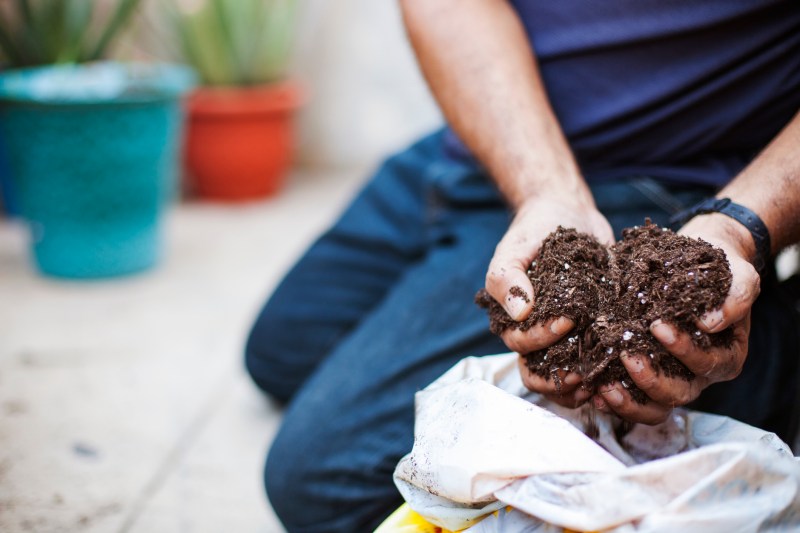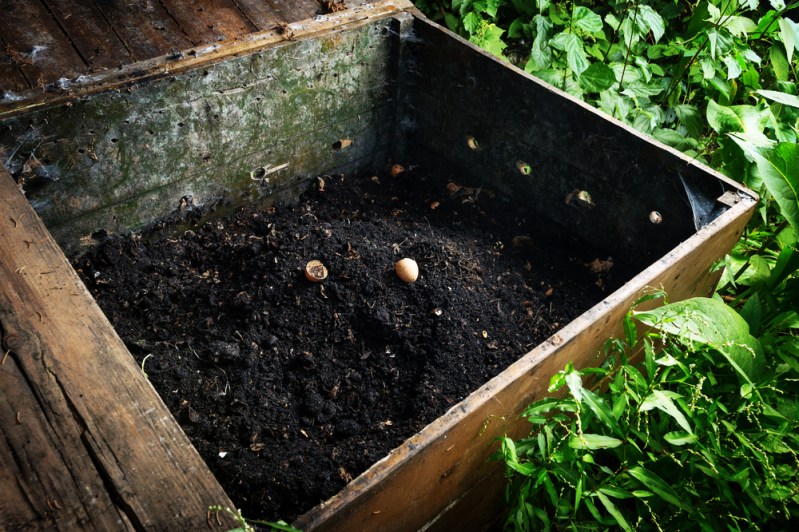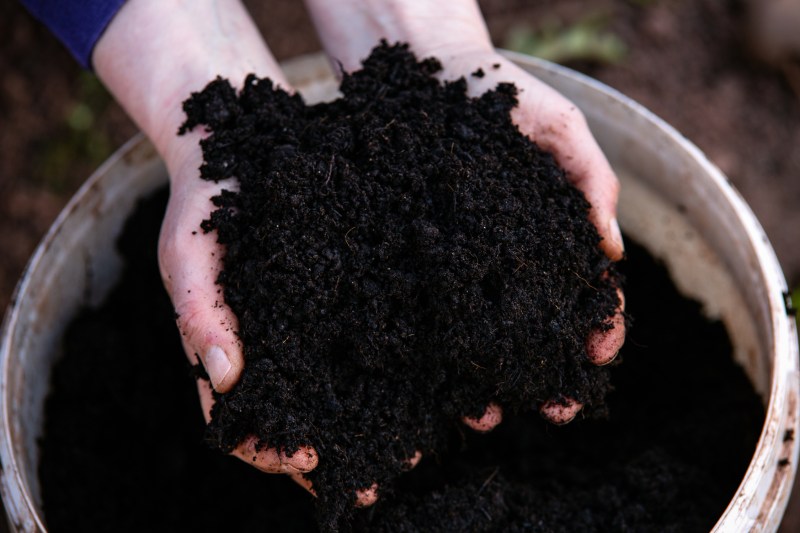
By decreasing the amount of waste you produce, you’re helping the planet. One of the easy ways to reuse waste that would otherwise get thrown away is to compost! This nutrient-rich, versatile product can be made in your backyard in just a few months. Composting is ridiculously easy to do and doesn’t require you to purchase anything. All you have to do is to divert the food scraps from your kitchen or the clippings from your yard (that would have normally gone in the garbage) to your compost bin. It might all seem pretty mystical — but in this post, we’ll review how to get from waste organic matter to a rich, dark end-product.
Related Guides
- Eco-Friendly Brands Help Save Our Oceans
- Sustainable Ways To Roadtrip This Summer
- How to Plant a Garden
How To Build a Compost Bin at Home

Ideally, your compost bin should be at least three feet wide and three feet deep. You can make your bin out of solely wood or of wood and mesh wire. Be sure the bin is on level ground, in a well-drained area that also gets decent sun exposure, and easily accessible. Don’t put your compost bin under direct sunlight, or in a very shady area. Too cold a temperature and your compost won’t decompose, and too hot a temperature and it’ll dry out. Avoid particularly windy patches of land, which can also dry out a compost pile. Compost piles are rich in nutrients, so placing them by trees will tend to cause the tree to spread its roots accordingly. It’s probably also a good idea to not place the bin against your house, as compost can smell sometimes. It’s decomposing organic matter, after all.
Once you’ve chosen the perfect location for your compost bin and constructed it, you’re ready to start composting! Keep in mind you always want a lot more carbon than nitrogen. Carbon-rich (brown) materials, like branches, brown paper bags, coffee filters, coffee grounds, dead leaves, eggshells, sawdust, and straw should dominate your compost pile. Start your compost pile off with a brown layer. Nitrogen-rich (green) materials, like food scraps, lawn clippings, and live leaves, should be used less often. To avoid bad smells, always put a layer of brown waste over a layer of green waste.
If it rains often where you live, place a piece of carpet over the pile; while compost should be moist, it should not be drenched. Your compost pile needs to be turned with a pitchfork at least weekly to add oxygen to the mix. You could also buy a compost aerator to achieve the same thing.
How Long Does It Take for Compost To Compost?
The length of time it takes food and yard waste to turn into compost is dependent on a few factors. A larger compost bin can retain more heat, so it will compost faster than a smaller one. The material of the compost bin is also important: plastic captures more heat than does wood. Layers of compost that are too thick (more than 20 cm) will take longer than normal to break down.
Compost piles have to be turned every so often, otherwise, they will take more time to turn into compost. Adding things to your compost pile, like trash, that don’t belong there can also lengthen the process. Disrupting the ratio of carbon to nitrogen will also be detrimental to forming compost.
A poorly assembled or aerated pile may take up to two years to produce usable results. However, if you carefully tend to your pile, you may see results as soon as three months after starting!
With attentive care and close to ideal conditions, you could even have useful compost within a month of starting your pile. A 30:1 ratio of finely shredded brown (oxygen) to green (nitrogen) materials is ideal for this method. By turning the pile daily, you’ll speed up the composting process, and you should have compost in approximately three weeks.
Alternatively, in a compost bin with a 30:1 brown to green ratio, you can add maggots to speed up decomposition. Maggots might look gross, but they’re quite the digesters! With maggots in your compost bin, you can use your compost in about three weeks. Adding earthworms to your bin will hurry the process along, as well, but not as much so as maggots. Known as vermicomposting, this method will result in compost with a higher nutrient content and a lower level of contaminants than normal.
What Should You Not Compost?

Lots of food waste can be placed in a compost bin, although there are a few things that you definitely shouldn’t compost. Meat, dairy, fruit stones, and diseased plants all have the potential to alter your compost pile in a negative way. Other non-compostable items include non-organic items such as glass or metal, most plastics, coal ash, and animal droppings. Any compostable item that has come into contact with pesticides or herbicides should also not be composted.
The inclusion of cooked vegetables in compost is a controversial subject. On average, cooked vegetables are 78% water – higher than the 50/50 ideal for composting. Alone, cooked vegetables have too much nitrogen to successfully decompose in a compost pile. You can temper the nitrogen content by adding an equal amount of dry, carbon-heavy material such as sawdust or straw. If you don’t properly compost cooked vegetables, they won’t decompose and you will end up with a smelly and/or rotten compost pile.
How To Use Compost

How do you know when your compost is finished? Usable compost is homogeneous and dark brown. It should easily crumble in your fingers and smell earthy. Letting your compost develop completely is important because before then, the material may contain substances that will continue to degrade when placed in soil. Additionally, unfinished compost uses up nitrogen and oxygen, which are also crucial to plant growth. If you’re unsure if your compost is done, there are tests that can help determine that.
Mature compost has many uses. All across the garden, compost will provide increased nutrients, improved water retention, and a balanced pH. Compost can be layered like mulch to prevent weeds from sprouting, or used to make potting soil. Compost can be spread across a yard or rows of freshly planted seeds, or fed to growing fruits and vegetables. This versatile, fertile material will help your house plants to flourish no matter where it’s placed.
Now you know lots about making compost. Get out there and stop throwing away food scraps! If you can’t compost due to space constraints or living situation, see if your town participates in commercial composting; if so, they may have a waste drop-off location.



